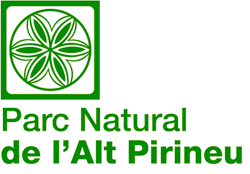NATURE

The Parc Natural de l'Alt Pirineu (Upper Pyrenees Natural Park), was created by Decree 194/2003 of the Generalitat de Catalunya on 1st August 2003. In October 2023, the Alt Pirineu Natural Park received EUROPARC (Sustainable Tourism in Protected Areas) accreditation. This Charter is much more than a mark of quality; it is a commitment by the managers of the natural spaces, tourist companies and other entities and agents which are active in this territory.
The park is located in the administrative districts of Pallars Sobirà (Spain) and l'Alt Urgell (Spain) and extends across a large area of the Catalan Pyrenees (Spain). With its area of 69,850 ha, it is the largest natural park in Catalonia (Spain) and its mountains include the highest peaks in Catalonia (Spain).
This is an area of great ecological value and scenic beauty, which preserves a series of traditional communal rights over the exploitation of local resources. These traditional rights have helped to define the area's cultural landscape and have contributed to the creation and conservation of its patrimony. It was decided that declaring this area a natural park was probably the best way of guaranteeing the protection of the ecological and cultural values contained within its boundaries and of establishing an administrative and organisational system capable of assuring the sustainable development of its territory.
The complex orography of this part of the Catalan Pyrenees, its physical size, landscape diversity, and wide range of altitudes, all combine to permit the existence of a very rich and varied range of geological structures, ecosystems, vegetation habitats and communities, fauna and landscapes.
Above all, it is important to stress the existence of zones of great geological interest; particularly with respect to their geomorphological, hydrological and hydro-geological features. By way of example, we could mention L'Estany de Certascan, which is the largest glacial lake in Catalonia, or La Cigalera de l'Obaga de Valeran (or of Jean Paul Larrégola), which is one of the deepest potholes in Catalonia, with a maximum depth of 320 m and a course of 365 m. It was contains elements of incommensurable natural value, such as an underground lake, several large caverns, and various galleries that follow the joints of the geological materials.
The park also houses a significant number of unique and interesting species of flora,nine of which have been given official protection. Almost all of the different types of habitat found in the area have been declared habitats of Community interest, in accordance with Directive 92/43/EEC. Some have even been considered worthy of priority protection, which is why part of the space will be included in the Nature 2000 Network. It is also important to stress the numerous examples of small forest communities in Catalonia, which include particular mixed deciduous woodlands, forests of birch saplings (Betula pubescens), beech woods and areas of mixed fir trees.
The fact that the area's fauna is so important within the scope of the project reflects the great number of vertebrate fauna that are considered interesting species. Some of these are endangered or vulnerable species and include populations of species referred to in annex IV to Directive 92/43/EEC and in annex I to Directive 74/409/EEC.
The generally good state of conservation that these spaces enjoy serves to further underline the global value of the park.
One of the most important examples of the wealth of this area is its extensive archaeological and architectural patrimony, with its most outstanding element being its Romanesque art. Although these are usually found in population the numerous examples of religious artwork (including altarpieces, engravings, and workings in gold and silver), combine to constitute one of the most important collections of Medieval and Baroque work to be found in the Pyrenees.
Other forms of communal forestry rights that have their origins in communal property are the "Societats de propietaris" (Societies of owners), or "Societats de veïns" (Societies of neighbours), which relate to private properties with multiple owners.
A knowledge of all of these cultural, social and economic questions will not only be necessary for guiding appropriate management of the Natural Park; they also, themselves, constitute objectives to be conserved, encouraged and promoted.
Contact information
Patronat de Turisme
de les Terres de Lleida
Rambla Ferran, 18 3rd floor
25007 Lleida
+34 973 245
408info@aralleida.cat
aralleida.cat
iònic.web